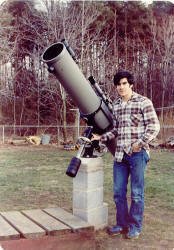 Waaaaay back in the early 1980s whilst in
the U.S. Air Force, I became interested in amateur astronomy. It was part of what
I call my enlightenment period, when I realized that studying mathematics,
science, and literature was a worth endeavor for something other than passing a
class in school. The astronomy club in Macon, Georgia, welcomed me into their fold,
and I received the benefit of their knowledge and their telescope collection. After
a few months I was manning the 8", 10", and 11" Celestrons in their observatory
during public viewing nights. We made a couple club field trips, with one being
to the Fernbank Science Center,
where we got to peer through the 36" Cassegrain telescope - what a treat that was!
When I got out of the USAF in 1982, one of the first things I did was purchase
the 8" Newtonian telescope shown to the right. I came from a telescope shop in Baltimore
for $600, about 30 miles from my parent's house in Mayo, Maryland. The motor drive
was missing at the time, but about a month later, the shopkeeper called to say he
had located it, so for a mere $200, I had a setup capable of taking astrophotos.
According to the inflation calculator on the U.S. Bureau of Labor website, that
$800 in 1982 is equivalent to about $1,880 in 2011. We've come a long way in value
since then.
Melanie and I got married in 1983, had our son in 1985, a daughter in 1986. By
then I rarely had a chance to observe, and we needed money more than a telescope,
so it, along with most of my model airplane equipment, was sold - in 1985 now that
I think about it. Life went on. I graduated with a Bachelor's degree in electrical
engineering in 1989, worked massive overtime for electronics companies, started
a business of my own, put the kids through college, and finally settled here in
Erie, Pennsylvania, in 2008. Finally, after 26 years of only being able to read
of others' exploits in Sky & Telescope, I finally broke down and bought a telescope
(June 2011) - a Celestron NexStar 8SE. The compactness of the Schmitt-Cassegrain
is a great convenience.
I also bought the eyepiece and filter kit from Celestron, along with a 9x60mm
finder scope from Orion, and a couple other minor accessories. Eventually I plan
to get a DSLR camera, but for now I'm using the Celestron NexImage camera. At a
mere 640x480 pixels, it ain't great but better than nothing. I'll post some pictures
as soon as the sky clears well enough to get some. We've been overcast every night
for a month now, except for the couple clear nights when the winds were too high
to get stable images.
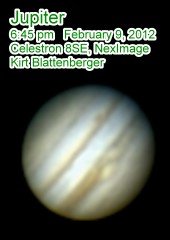  To the left is more recent image (2/9/2012)
of Jupiter. I'm getting a little better. The sky was exceptionally clear, winds
nonexistent, and the nearly full moon had not risen above the eastern horizon yet.
Jupiter was about 15° west of due south, high in the sky. My Celestron NexImage
was used with a 2x Barlow lens. The photo is a composite of about 500 short time
exposure images recorded at 5 fps. This really helped avoid atmospheric scintillation.
RegiStax v2 software was used. To the left is more recent image (2/9/2012)
of Jupiter. I'm getting a little better. The sky was exceptionally clear, winds
nonexistent, and the nearly full moon had not risen above the eastern horizon yet.
Jupiter was about 15° west of due south, high in the sky. My Celestron NexImage
was used with a 2x Barlow lens. The photo is a composite of about 500 short time
exposure images recorded at 5 fps. This really helped avoid atmospheric scintillation.
RegiStax v2 software was used.
To the right is my first ever image of Venus on the same evening. Venus was about
45° west of due south, closer to the horizon, but still high enough to avoid a lot
of the denser part of the atmosphere. It is a composite of about 200 frames.
Here is a page I posted on my RF Cafe website with a few
astrophotos taken
using a Canon S1 2S Power Shot, mounted on a tripod. That type of camera cannot
be used with a standard telescope adapter because the lens is not removable.
 Side-by-side comparisons of my photos to those
in A Field Guide to the Stars and Planets, by Donald H. Menzel, published
by Houghton Mifflin Company of Boston, copyright 1964. My photos were taken with
a Minolta XG-1 SLR mounted on top the 8" Newtonian telescope show above. This wide
of a field of view cannot be obtained through the telescope eyepiece. The scope
was located on a pier with an equatorial mount in my parent's back yard in
Holly
Hill Harbor, Mayo, Maryland, sometime around 1982 or 1983, shortly after I got
out of the USAF. Click on images for larger versions. Side-by-side comparisons of my photos to those
in A Field Guide to the Stars and Planets, by Donald H. Menzel, published
by Houghton Mifflin Company of Boston, copyright 1964. My photos were taken with
a Minolta XG-1 SLR mounted on top the 8" Newtonian telescope show above. This wide
of a field of view cannot be obtained through the telescope eyepiece. The scope
was located on a pier with an equatorial mount in my parent's back yard in
Holly
Hill Harbor, Mayo, Maryland, sometime around 1982 or 1983, shortly after I got
out of the USAF. Click on images for larger versions.
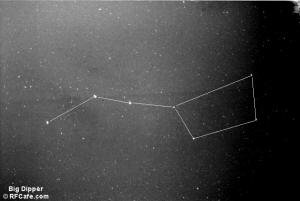 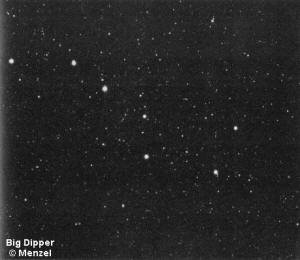
Kirt Blattenberger photo
Menzel photo
Big Dipper Asterism in the Constellation of Ursa Major
 
Kirt Blattenberger photo
Menzel photo
Cassiopeia Constellation
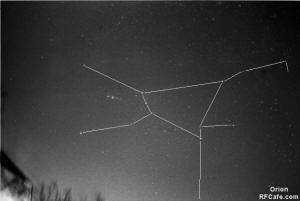 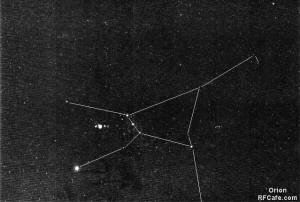
Kirt Blattenberger photo
Menzel photo
Orion Constellation
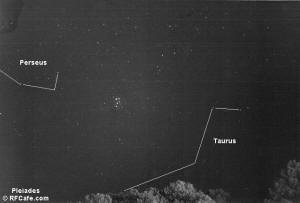 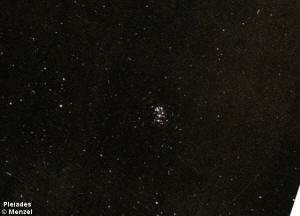
Kirt Blattenberger photo
Menzel photo
Pleiades Asterism in the Constellation of Taurus
Posted July 17, 2023
(updated from original post
on 9/2424/2011)
|